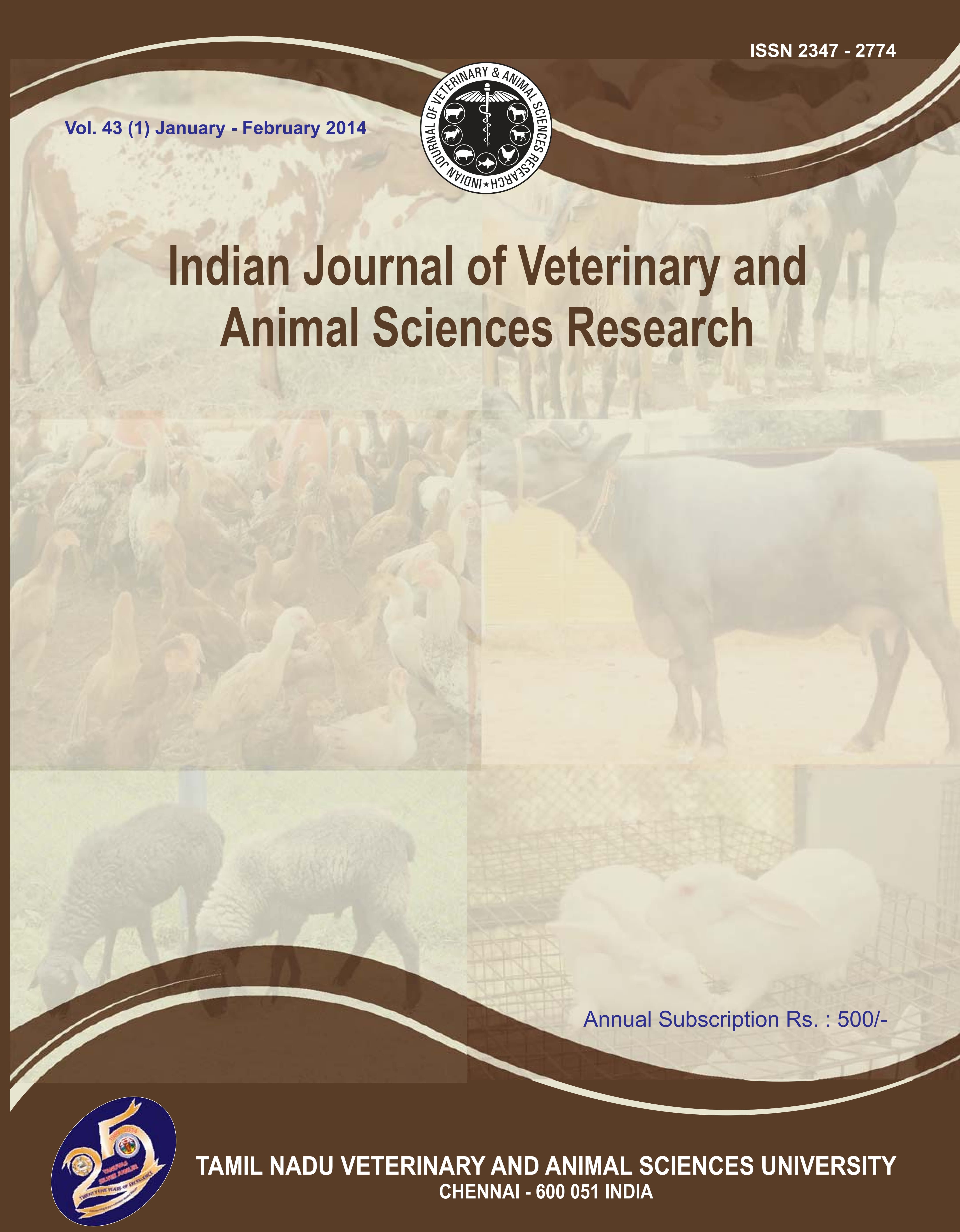MANAGEMENT OF SEVERE HEPATIC COCCIDIOSIS IN DOMESTIC RABBITS
61 / 14
Keywords:
Hepatic coccidiosis, Rabbits, Eimeria stiedai, KeralaAbstract
High mortality in a period of one month due to hepatic coccidiosis was reported in a rabbit farm. Typical nodular lesions in liver and unsporulated oocysts of E. stiedai could be detected. Animals were treated with sulphaquinoxyline and diaveridine for five days followed by repetition of treatment after five days. Strict sanitary measures and disinfection of cages by spraying with 10 per cent ammonia solution was adopted. All animals with poor body conditions were removed from the flock and the disease was controlled.
Downloads
References
Abu-Akkada, S.S., Oda, S.S. and Ashmawy, K.I. (2010). Garlic and hepatic coccidiosis: Prophylaxis or treatment? Tropical Animal Health Production, 42(7): 1337 – 1343.
Al-Mathal, E.M. (2010). Efficacy of Commiphora molmol against hepatic coccidiosis ( Eimeia stiedai ) in domestic rabbit. Journal of Food, Agriculture and Environment, 8(3&4): 1072 – 1080.
Barriga, O.O. and Arnoni, J. V. (1981). Pathophysiology of hepatic coccidiosis in rabbits. Veterinary Parasitology, 8: 201 – 210.
Bautista, M.G., Vazquez, F.A. and Alunda, J.M. (1987). The effect of the host’s age on the pathology of Eimeria stiedai infection in rabbit. Veterinary Parasitology, 24: 47 – 57.
D’Souza, P.E., Rajeshwari, Y.B., Jagannath, M.S. and Rahman, S.A. (1992). Coccidiosis in rabbits. Livestock Advertising, 17: 26 – 28.
Jithendran, K.P. and Bhat, T.K. (1995). Subclinical coccidiosis in Angora rabbits, a field survey in Himachal Pradesh. World Rabbit Sciences, 4: 29 – 32.
Laha, R., Hemaprasanth, D.A. and Harbola, P.C. (1999). Comparative efficacy of sulphadimidine and combination of amprolium, sulphaquinoxaline in the control of natural coccidial infection in rabbits. Indian Veterinary Journal, 76: 1013 – 1015.
Lakshmanan, B., Ravindran, R., Vasudeven, V.N. and Devada, K. (2011). Hepatic coccidiosis in rabbits in Kerala. Journal of Indian Veterinary Association, 9(2): 56 – 57.
Magray, A., Khan A.R. and Rashid, M. (2010). Study on fatal hepatic coccidiosis in rabbits of Kashmir Valley. Journal of Environment and Bio Sciences, 24: 243 – 245.
Pakandl, M. (2009). Coccidia of rabbit: a review. Folia. Parasitologica. 56(3):153–166.
Palanivel, K.M., Sureshkumar, K. and Rishikesavan, R. (2013). Prevalence of hepatic coccidiosis in rabbits – A post- mortem analysis. Indian Veterinary Journal, 90(11): 72 – 73
Pillai, K.M. and Subramanian, H. (1993). Intestinal coccidiosis of rabbits in Kerala. Journal of Veterinary Animal Sciences, 24(2):190 – 191.
Rajkhowa, C. (1996). Incidence of rabbit coccidiosis in Meghalaya and its control. Journal of Veterinary Parasitology, 10:175 – 178.
Shameem, H. and Devada, K. (2005). Prevalence of rabbit coccidiosis in Thrissur. Journal of Veterinary Parasitology, 19(1): 69 – 70.
Singla, L.D., Juyal, P.D. and Sandhu, B.S. (2000). Pathology and therapy in naturally E. stiedai infected rabbits. Journal of Protozoology Research, 10: 185 – 191.
Downloads
Submitted
Published
Issue
Section
License
All the copy right belongs to the sponsoring Organization, Tamil Nadu Veterinary and Animal Sciences University, Chennai - 51.

